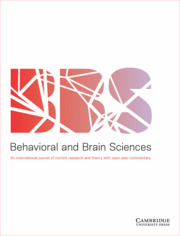Crossref Citations
This article has been cited by the following publications. This list is generated based on data provided by Crossref.
Stein, Dan J.
2008.
Psychobiology of Anxiety Disorders and Obsessive-Compulsive Spectrum Disorders.
CNS Spectrums,
Vol. 13,
Issue. S14,
p.
23.
Henrich, Joseph
2009.
The evolution of costly displays, cooperation and religion.
Evolution and Human Behavior,
Vol. 30,
Issue. 4,
p.
244.
Cosmides, Leda
Barrett, H. Clark
and
Tooby, John
2010.
Adaptive specializations, social exchange, and the evolution of human intelligence.
Proceedings of the National Academy of Sciences,
Vol. 107,
Issue. supplement_2,
p.
9007.
Lienard, Pierre
2011.
Life stages and risk-avoidance: Status- and context-sensitivity in precaution systems.
Neuroscience & Biobehavioral Reviews,
Vol. 35,
Issue. 4,
p.
1067.
Stein, Dan J.
and
Nesse, Randolph M.
2011.
Threat detection, precautionary responses, and anxiety disorders.
Neuroscience & Biobehavioral Reviews,
Vol. 35,
Issue. 4,
p.
1075.
Sibley, Chris G.
Bulbulia, Joseph
and
Sánchez, Angel
2012.
Faith after an Earthquake: A Longitudinal Study of Religion and Perceived Health before and after the 2011 Christchurch New Zealand Earthquake.
PLoS ONE,
Vol. 7,
Issue. 12,
p.
e49648.
Hoverd, William J.
Bulbulia, Joseph
and
Sibley, Chris G.
2013.
Does poverty predict religion?.
Religion, Brain & Behavior,
Vol. 3,
Issue. 3,
p.
185.
Veale, David
and
Gilbert, Paul
2014.
Body dysmorphic disorder: The functional and evolutionary context in phenomenology and a compassionate mind.
Journal of Obsessive-Compulsive and Related Disorders,
Vol. 3,
Issue. 2,
p.
150.
Legare, Cristine H.
and
Souza, André L.
2014.
Searching for Control: Priming Randomness Increases the Evaluation of Ritual Efficacy.
Cognitive Science,
Vol. 38,
Issue. 1,
p.
152.
Belayachi, Sanaâ
and
Van der Linden, Martial
2015.
Exploring the Parsing of Dynamic Action in Checking Proneness.
Behaviour Change,
Vol. 32,
Issue. 2,
p.
93.
Murray, Damian R.
and
Schaller, Mark
2016.
Vol. 53,
Issue. ,
p.
75.
Bassi, Francesca
2016.
Atos rituais: eventos, agências e eficácias no Candomblé.
Religião & Sociedade,
Vol. 36,
Issue. 2,
p.
244.
Ron, Omri
Oren, Ela
and
Dar, Reuven
2016.
The doubt-certainty continuum in psychopathology, lay thinking, and science.
Journal of Behavior Therapy and Experimental Psychiatry,
Vol. 53,
Issue. ,
p.
68.
Hobson, Nicholas M
and
Inzlicht, Michael
2016.
Arbitrary Rituals Mute the Neural Response to Performance Failure.
SSRN Electronic Journal,
Brooks, Alison Wood
Schroeder, Juliana
Risen, Jane L.
Gino, Francesca
Galinsky, Adam D.
Norton, Michael I.
and
Schweitzer, Maurice E.
2016.
RETRACTED: Don’t stop believing: Rituals improve performance by decreasing anxiety.
Organizational Behavior and Human Decision Processes,
Vol. 137,
Issue. ,
p.
71.
Taylor, Jasmine
and
Purdon, Christine
2016.
Responsibility and hand washing behaviour.
Journal of Behavior Therapy and Experimental Psychiatry,
Vol. 51,
Issue. ,
p.
43.
Hobson, Nicholas M.
Bonk, Devin
and
Inzlicht, Michael
2017.
Rituals decrease the neural response to performance failure.
PeerJ,
Vol. 5,
Issue. ,
p.
e3363.
Slingerland, Edward
and
Sullivan, Brenton
2017.
Durkheim with Data: The Database of Religious History.
Journal of the American Academy of Religion,
Vol. 85,
Issue. 2,
p.
312.
Hobson, Nicholas M
Risen, Jane
and
Inzlicht, Michael
2017.
The Psychology of Rituals: An Integrative Review and Process-Based Framework.
SSRN Electronic Journal,
Belayachi, S.
and
Van Der Linden, M.
2017.
Checking Heterogeneity and its Relationships with Action Identification Level.
Journal of Experimental Psychopathology,
Vol. 8,
Issue. 3,
p.
214.

